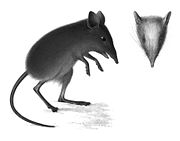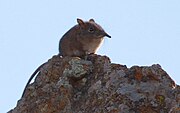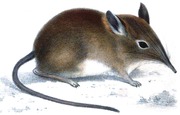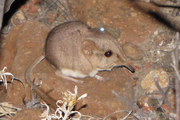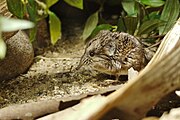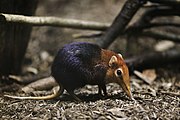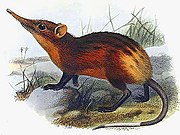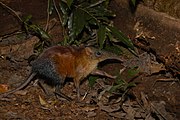Macroscelidea is an order of small mammals. Members of this order are called macroscelids, or elephant shrews. They are exclusively found in Africa, in a variety of biomes from forests to deserts. They range in size from the Etendeka round-eared sengi, at 8 cm (3 in) plus a 8 cm (3 in) tail, to the grey-faced sengi, at 32 cm (13 in) plus a 26 cm (10 in) tail, and generally eat insects, other invertebrates, and plants. The only macroscelid species with an International Union for Conservation of Nature (IUCN) population estimate is the golden-rumped elephant shrew, listed as endangered with a population of around 13,000.

The nineteen extant species of Macroscelidea are grouped into a single family, Macroscelididae, and are split between six genera. Dozens of extinct macroscelid species have been discovered, though due to ongoing research and discoveries the exact number and categorization is not fixed.[1]
Conventions
| Conservation status | |
|---|---|
| EX | Extinct (0 species) |
| EW | Extinct in the wild (0 species) |
| CR | Critically Endangered (0 species) |
| EN | Endangered (1 species) |
| VU | Vulnerable (1 species) |
| NT | Near threatened (0 species) |
| LC | Least concern (13 species) |
| Other categories | |
| DD | Data deficient (4 species) |
| NE | Not evaluated (0 species) |
Conservation status codes listed follow the IUCN Red List of Threatened Species. Range maps are provided wherever possible; if a range map is not available, a description of the macroscelid's range is provided. Ranges are based on the IUCN Red List for that species unless otherwise noted. All extinct species or subspecies listed alongside extant species went extinct after 1500 CE, and are indicated by a dagger symbol "†".
Classification
The order Macroscelidea consists of a single family, Macroscelididae, which contains twenty species divided into six genera. Many of these species are further subdivided into subspecies. This does not include hybrid species or extinct prehistoric species.[2]
Family Macroscelididae
- Genus Elephantulus (round-eared elephant shrews): eight species
- Genus Galegeeska (Horn of Africa elephant shrews): two species
- Genus Macroscelides (long-eared elephant shrews): three species
- Genus Petrodromus (four-toed elephant shrew): one species
- Genus Petrosaltator (North African elephant shrew): one species
- Genus Rhynchocyon (checkered elephant shrews): four species
Macroscelids
The following classification is based on the taxonomy described by Mammal Species of the World (2005), with augmentation by generally accepted proposals made since using molecular phylogenetic analysis.[3]
| Common name | Scientific name and subspecies | Range | Size and ecology | IUCN status and estimated population |
|---|---|---|---|---|
| Bushveld elephant shrew | E. intufi (Smith, 1836) | Southern Africa | Size: 20–28 cm (8–11 in) long, plus 9–15 cm (4–6 in) tail[4] Habitat: Savanna, shrubland, and grassland[5] Diet: Ants, termites, and other small invertebrates, as well as plants[4] | LC
|
| Cape elephant shrew | E. edwardii (Smith, 1839) | Southern South Africa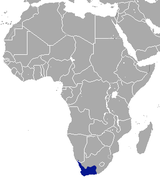 | Size: 10–13 cm (4–5 in) long, plus 11–15 cm (4–6 in) tail[6] Habitat: Shrubland and rocky areas[7] Diet: Ants and termites, as well as other invertebrates[6] | LC
|
| Dusky elephant shrew | E. fuscus (Peters, 1852) | Southern Africa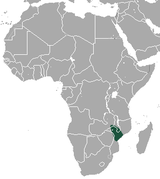 | Size: 10–13 cm (4–5 in) long, plus 8–12 cm (3–5 in) tail[8] Habitat: Savanna and shrubland[9] Diet: Believed to be invertebrates[10] | DD
|
| Dusky-footed elephant shrew | E. fuscipes (Thomas, 1894) | Central Africa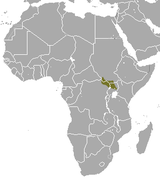 | Size: 12–15 cm (5–6 in) long, plus 8–10 cm (3–4 in) tail[11] Habitat: Savanna[12] Diet: Believed to be invertebrates[10] | DD
|
| Eastern rock elephant shrew | E. myurus Thomas, Schwann, 1906 | Southern Africa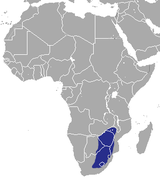 | Size: 20–29 cm (8–11 in) long, plus 20–29 cm (8–11 in) tail[13] Habitat: Savanna, grassland, and rocky areas[14] Diet: Ants, termites, and other invertebrates, as well as plants[13] | LC
|
| Karoo rock elephant shrew | E. pilicaudus Smit, Robinson, Watson, van Vuuren, 2008 | Western South Africa | Size: 11–12 cm (4–5 in) long, plus 11–15 cm (4–6 in) tail[15] Habitat: Shrubland and rocky areas[16] Diet: Invertebrates[15] | DD
|
| Short-snouted elephant shrew | E. brachyrhynchus (Smith, 1836) | Southern and southeastern Africa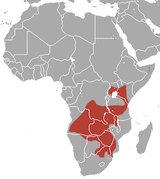 | Size: 11–13 cm (4–5 in) long, plus 8–11 cm (3–4 in) tail[17] Habitat: Savanna and grassland[18] Diet: Ants and termites, as well as small amounts of plants, fruit, and seeds[19] | LC
|
| Western rock elephant shrew | E. rupestris (Smith, 1831) | Southern Africa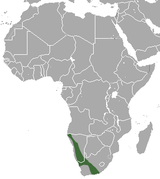 | Size: 11–13 cm (4–5 in) long, plus 12–17 cm (5–7 in) tail[20] Habitat: Savanna, shrubland, and rocky areas[21] Diet: Invertebrates[20] | LC
|
| Common name | Scientific name and subspecies | Range | Size and ecology | IUCN status and estimated population |
|---|---|---|---|---|
| Somali elephant shrew | G. revoili (Huet, 1881) | Horn of Africa | Size: 12–15 cm (5–6 in) long, plus 12–16 cm (5–6 in) tail[22] Habitat: Savanna and shrubland[23] Diet: Invertebrates as well as plants[22] | DD
|
| Rufous elephant shrew | G. rufescens (Peters, 1878) Six subspecies
| Eastern Africa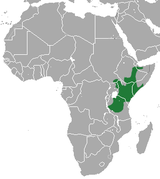 | Size: 10–20 cm (4–8 in) long, plus 11–17 cm (4–7 in) tail[24] Habitat: Savanna and grassland[25] Diet: Termites and ants, as well as shoots, berries and roots[26] | LC
|
| Common name | Scientific name and subspecies | Range | Size and ecology | IUCN status and estimated population |
|---|---|---|---|---|
| Etendeka round-eared sengi | M. micus Dumbacher, Rathbun, 2014 | Northwestern Namibia | Size: 8–10 cm (3–4 in) long, plus 8–10 cm (3–4 in) tail[27] Habitat: Shrubland, grassland, and desert[28] Diet: Invertebrates[29] | LC
|
| Namib round-eared sengi | M. flavicaudatus Lundholm, 1955 | Namibia | Size: 10–12 cm (4–5 in) long, plus 9–14 cm (4–6 in) tail[27][30] Habitat: Shrubland and desert[31] Diet: Omnivorous, primarily invertebrates[30] | LC
|
| Round-eared elephant shrew | M. proboscideus (Shaw, 1800) | Southern Africa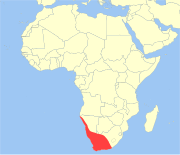 | Size: 10–11 cm (4–4 in) long, plus 9–13 cm (4–5 in) tail[32] Habitat: Shrubland and desert[33] Diet: Termites, ants, and other small invertebrates, as well as plants[32] | LC
|
| Common name | Scientific name and subspecies | Range | Size and ecology | IUCN status and estimated population |
|---|---|---|---|---|
| Four-toed elephant shrew | P. tetradactylus Peters, 1846 Nine subspecies
| Central and southeastern Africa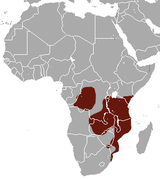 | Size: 19–23 cm (7–9 in) long, plus 15–17 cm (6–7 in) tail[34] Habitat: Forest, savanna, and shrubland[35] Diet: Termites, ants, and other small invertebrates, as well as plants[34] | LC
|
| Common name | Scientific name and subspecies | Range | Size and ecology | IUCN status and estimated population |
|---|---|---|---|---|
| North African elephant shrew | P. rozeti (Duvernoy, 1833) Two subspecies
| Northwestern Africa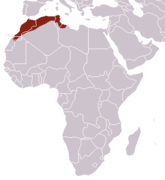 | Size: 11–13 cm (4–5 in) long, plus 13–16 cm (5–6 in) tail[36] Habitat: Shrubland, rocky areas, and desert[37] Diet: Believed to be ants, termites, and other invertebrates, as well as plants[36] | LC
|
| Common name | Scientific name and subspecies | Range | Size and ecology | IUCN status and estimated population |
|---|---|---|---|---|
| Black and rufous elephant shrew | R. petersi Bocage, 1880 Two subspecies
| Eastern Africa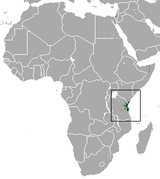 | Size: 25–31 cm (10–12 in) long, plus 25 cm (10 in) tail[38] Habitat: Forest and shrubland[39] Diet: Omnivorous; primarily ants, termites, and other invertebrates[38] | LC
|
| Checkered elephant shrew | R. cirnei Peters, 1847 Six subspecies
| Central and southeastern Africa | Size: 22–31 cm (9–12 in) long, plus 17–26 cm (7–10 in) tail[40] Habitat: Forest and shrubland[41] Diet: Invertebrates, as well as small mammals, amphibians, mollusks, birds, and bird eggs[40] | LC
|
| Golden-rumped elephant shrew | R. chrysopygus Günther, 1881 | Eastern Kenya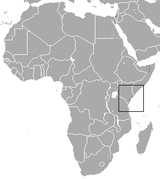 | Size: 21–31 cm (8–12 in) long, plus 21–27 cm (8–11 in) tail[42] Habitat: Forest and shrubland[43] Diet: Wide variety of invertebrates[44] | EN
|
| Grey-faced sengi | R. udzungwensis Rovero, Rathbun, 2008 | Central Tanzania | Size: 29–32 cm (11–13 in) long, plus 23–26 cm (9–10 in) tail[45] Habitat: Forest[46] Diet: Unknown[45] | VU
|
References
Sources
- Schlitter, Duane A. (2005). Wilson, Don E.; Reeder, DeeAnn M. (eds.). Mammal Species of the World. Vol. 1 (3rd ed.). Johns Hopkins University Press. ISBN 978-0-8018-8221-0.
- Kingdon, Jonathan; Happold, David; Butynski, Thomas; Hoffmann, Michael; Happold, Meredith; Kalina, Jan, eds. (2013). Mammals of Africa. Vol. 1. Bloomsbury Publishing. ISBN 978-1-4081-8996-2.


